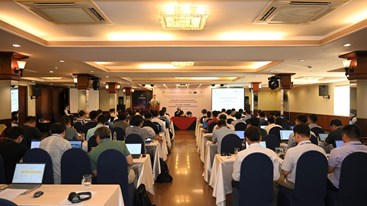Friday, 17/05/2024 | 10:27 GMT+7
The
The project developed by the Energy Conservation Research and
Making effective use of rice husk
Enerteam director, Le Hoang Viet, said the brick furnaces consisted of four chambers (baking, heating up, drying and cooling) operating under a circulating mechanism with continuous exchanges in their functions. The hot smoke in the baking chamber is then reused in the heating-up and the drying chambers.
These associated chambers will have their functions
continuously exchanged for a sustained burning process. The finished bricks
will be taken out from the cooling chamber, the workers will then load raw
bricks in this chamber and it will turn into a baking chamber.

Each chamber has a holding capacity ranging from 1,800 to 3,000 bricks based on the designs. Each burning cycle lasts for 12 hours.
The brick furnaces employing rice husk gasification
technology help reduce gas emissions significantly. Besides, it also reaches
the
Eco-friendly technology
A member of the study team, engineer Thu Giang, said the brick furnaces employing rice husk gasification technology would raise energy efficiency in the clay production industry considerably.
By making use of local plentiful rice husk sources (an agricultural waste) as a fuel to replace fossil fuel (coal) the new furnaces help lower the production cost markedly while protecting the environment in a practical way with significantly lowered carbon dioxide emissions.
The gasification system ensures stable blaze and temperature level. There also exists a temperature control system that is compatible to diverse brick types. Therefore, the finished products can satisfy strict quality and technical requirements catered to top-of-the line items such as roof tiles or enameled bricks.
The gas created by burning rice husk will go through one or several filter sets to become purified. The number of the filter set depends on the product quality and technical specifications (for example, glazed ceramic tiles require high technical requirements).
At the end of the thermolysis process, the workers pour water into the rice husk ash to drive it to a specialized task. The water will then be reused with the same task. The system does not discharge water-water into the environment. The ash is then piled up for sale to gardeners (sugarcane fields or flower gardens).
The result outcome was applied at the Tan Mai Company in Sa Dec town, Dong Thap province that produces ceramic items, tiles and bricks with an annual capacity of 650,000 items on average at a stable quality.
Caption: The brick furnaces using rice husk gasification technology consume 35 percent less rice husk compared to traditional furnaces, and turn out better-quality bricks.
By Viet Nhan





.png?w=367&h=206&mode=crop)


.jpg?w=367&h=206&mode=crop) Energy efficiency and conservation usage is an important aspect of the national energy development strategy
05/03/2024
Energy efficiency and conservation usage is an important aspect of the national energy development strategy
05/03/2024
 Challenges and Opportunities to promote energy efficiency market in Vietnam
Challenges and Opportunities to promote energy efficiency market in Vietnam
 The Ministry of Industry and Trade requests government agencies to coordinate in organizing Earth Hour 2024
The Ministry of Industry and Trade requests government agencies to coordinate in organizing Earth Hour 2024
 Consultation on Energy Efficiency Boiler Catalogue and Wood Drying Guideline
Consultation on Energy Efficiency Boiler Catalogue and Wood Drying Guideline
.png?w=367&h=206&mode=crop) Request for expression of interest - C2.1.13: Capacity Building on energy efficiency policies development
Request for expression of interest - C2.1.13: Capacity Building on energy efficiency policies development
 Son Ha Co., Ltd, applies energy efficiency and conservation measures
Son Ha Co., Ltd, applies energy efficiency and conservation measures
 Phuc Kien Co., Ltd., is effectively implementing energy-saving measures
Phuc Kien Co., Ltd., is effectively implementing energy-saving measures
 Request for expression of interest - C2.1.12: Independent monitoring of safeguards implementation
Request for expression of interest - C2.1.12: Independent monitoring of safeguards implementation